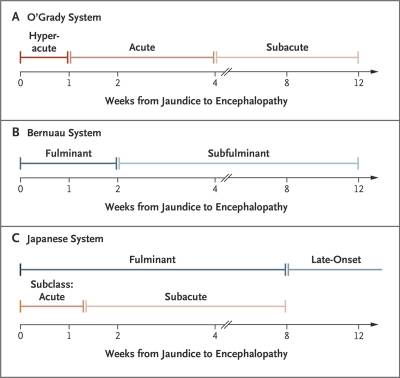Acute Liver Failure
- A specific term used to refer to:
- acute abnormality of Liver Function Tests in someone without underlying liver disease as opposed to Acute on Chronic Liver disease and others
- is associated with a coagulopathy which is different from the coagulopathy of sepsis. The coagulopathy required is determined as: INR >1.5 or prolonged PT
- and have altered consciousness.
- 'ALF' with coagulopathy but no change in consciousness is termed Acute Liver Injury
- ALF begins as ALI with 2 to 3 fold increase in transaminases, coagulopathy and jaundice
Exceptions to the 'previous liver disease' rule include: the de novo presentation of autoimmune hepatitis, Budd-Chiari syndrome and Wilson disease as these will not have been diagnosed before, and those patients who have evidence of liver pathology but did not have overt disease. They all share the same poor prognosis.
| Acute Liver Failure is often graded: | |
|---|---|
| hyperacute | • <10/7 from onset of jaundice to encephalopathy • severe coagulopathy • markedly increased transaminases • modest if any increase in Bilirubin |
| acute/fulminant | • 10-30/7 from onset of jaundice to encephalopathy |
| subacute | • 5-24/52 from onset of jaundice to encephalopathy • mild/moderate coagulopathy • milder increase in transaminases • deep jaundice • often have splenomegaly, ascites |
| Classification of Hepatic encephalopathy (West Haven criteria) | |
|---|---|
| Stage | Clinical |
| I | Euphoria, depression, some disorientation, slurred speech, sleep disturbance, may have asterixis |
| II | Lethargy, moderate disorientation, asterixis |
| III | marked disorientation, can be roused when somnolent, asterixis |
| IV | coma, initially reacting to painful stimuli |
Management, especially transplant, is then dependent on aetiology:
- malignant infiltration
- hypoxic/ischaemic - AST +++ (usually >2x ALT), often with normal Bili (similar to Paracetamol OD picture)
- other systemic and infective related - autoimmune, malaria, dengue, rickettsiosis, viruses and fungi
- HepB, HepA and HepE
- some toxins - yellow phosphorous
- drugs - paracetamol, anti TB agents, antibiotics (nitrfuratoin, ketokonazole), antiepileptics (phenytoin, valproate), NSAIDs
- other - unknown cause despite Ix
Management
- fluid resuscitation and possibly vasopressors
- attention to pre-emptive causes - ischaemia/hypoxia/OD etc
- administration of coagulation factors is not advised
- ulcer prophylaxis
- N-acetyl cysteine if paracetamol OD
- treatment or prevention of encephalopathy is problematic - regimens to treat ↑ammonia levels in chronic liver disease have not been beneficial in prevention in the acute illness
- liver transplant (the only curative Rx) based on scoring systems - eg. Kings' College, Clichy criteria, MELD, CK/modified MELD, BiLE score
| Kings' College criteria | |
|---|---|
| Paracetamol OD | art pH <7.25.. or 2 of: • INR<6.5 • C>300μmol/L • encephalopathy grade 3-4 |
| other causes | INR>6.5.. or 3 of: • age<10 or >40y • aetiology unclear or medication • INR>3.5 • Bili >300μmol/L |
MELD score
- The Model for End-Stage Liver Disease, or MELD, is a scoring system for assessing the severity of chronic liver disease
- MELD uses the patient's values for serum bilirubin, serum creatinine, and the international normalized ratio for prothrombin time (INR) to predict survival. Calculated according to the following formula:
- MELD = 3.78×ln[serum bilirubin (mg/dL)] + 11.2×ln[INR] + 9.57×ln[serum creatinine (mg/dL)] + 6.43 (conversion from μmol/L to mg/dl, multiply by 0.0113. To convert mg/dl to μmol/L, multiply by 88.4)
MELD scores are reported as whole numbers, so the result of the equation above is rounded.
Child-Pugh score
- used to assess the prognosis of chronic liver disease, mainly cirrhosis
- 5 clinical measures of liver disease with each measure scored 1–3, with 3 indicating most severe derangement. Either the PT or INR should be used not both.
| Measure | 1 point | 2 points | 3 points |
|---|---|---|---|
| Total bilirubin, μmol/L (mg/dL) | < 34 (< 2) | 34–50 (2–3) | > 50 (> 3) |
| Serum albumin, g/dL | > 3.5 | 2.8–3.5 | < 2.8 |
| Prothrombin time, prolongation (s) | < 4.0 | 4.0–6.0 | > 6.0 |
| INR | < 1.7 | 1.7–2.3 | > 2.3 |
| Ascites | None | Mild (or suppressed with medication) | Moderate to severe (or refractory) |
| Hepatic encephalopathy | None | Grade I–II | Grade III–IV |
*Chronic liver disease is classified into Child–Pugh class A to C, employing the added score from above
| Points | Class | One-year survival | Two-year survival |
|---|---|---|---|
| 5–6 | A | 100% | 85% |
| 7–9 | B | 80% | 60% |
| 10–15 | C | 45% | 35% |
